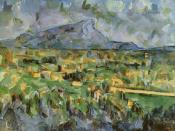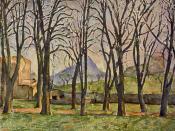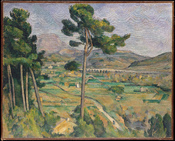Paul Cézanne was born as the son of a wealthy banker in a southern French town called Aix-en-Provence on January 19, 1839. His closest boyhood friend was Emile Zola, who later gained fame for his novels and letters. Both boys developed artistic interest early in their lives. This idea greatly dismayed Cézanne's father. No one could have guessed it then, but Cézanne would be become a famous French painter who would come to be called the father of modern art.
After a variety of heated family disputes, Cézanne was finally given a small allowance and sent to study art in Paris in 1862. Zola had already gone there, and was still studying there. Paul was most intrigued by the more radical elements of the art world. He admired the romantic painter Eugene Delacroix, and some younger artists including Gustave Courbet and â¹douard Manet. These painters exhibited realistic paintings that were unexpected and shocking in both style and subject compared to other contemporary artists.
Cézanne adopted similar styles at first.
Cézanne's early works were usually painted with dark tones and heavy, fluid pigments, which reflected the moody and romantic expressionism of earlier generations. He gradually developed a method of the representation of contemporary life. He painted the world as he saw without concern for idealistic themes or stylish affectation. The most significant influence on Cézanne at this time was Camille Pissaro who not only provided Cézanne with the moral encouragement that he needed, but he introduced Cézanne to a new impressionistic technique for rendering outdoor light. Because of Pissaro's influence, Cézanne shifted from dark tones to bright hues concentrating greatly on scenes of farmland and rural villages.
Cézanne seemed to be less technically accomplished than other impressionists at that time, and received some of the harshest critical commentary. He drifted...


